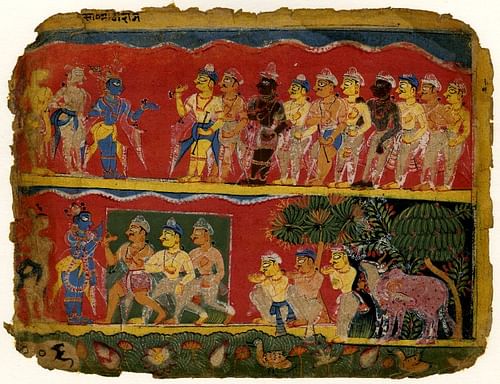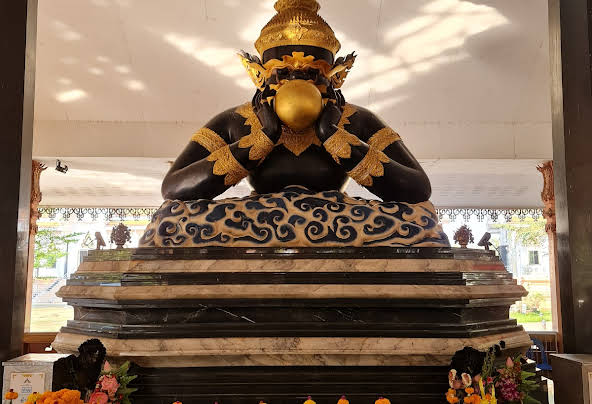---------------
1 I.e., personality and fatness, &c.
2 I read dehe for dehaḥ.
3 Literally, “must be an attribute of the subject and have invariable concomitance (vyápti).”
4 For the sandigdha and niśchita upádhi see Siddhánta Muktávali, p. 125. The former is accepted only by one party.
6
We will first show that it is not perception. Now perception is held to be of two kinds, external and internal [i.e., as produced by the external senses, or by the inner sense, mind]. The former is not the required, means; for although it is possible that the actual contact of the senses and the object will produce the knowledge of the particular object thus brought in contact, yet as there can never be such contact in the case of the past or the future, the universal proposition1 which was to embrace the invariable connection of the middle and major terms in every case becomes impossible to be known. Nor may you maintain that this knowledge of the universal proposition has the general class as its object, because if so, there might arise a doubt as to the existence of the invariable connection in this particular case2 [as, for instance, in this particular smoke as implying fire].
Nor is internal perception the means, since you cannot establish that the mind has any power to act independently towards an external object, since all allow that it is dependent on the external senses, as has been said by one of the logicians, “The eye, &c., have their objects as described; but mind externally is dependent on the others.”
Nor can inference be the means of the knowledge of the universal proposition, since in the case of this inference we should also require another inference to establish it, and so on, and hence would arise the fallacy of an ad infinitum retrogression.
Nor can testimony be the means thereof, since we may either allege in reply, in accordance with Vaiśeshika doctrine of Kaṇáda, that this is included in the topic of inference; or else we may hold that this fresh proof of testimony is unable to leap over the old barrier that
---------------
1 Literally, the knowledge of the invariable concomitance (as of smoke by fire).
2 The attributes of the class are not always found in every member, - thus idiots are men, though man is rational animal; and again, this particular smoke might be a sign of a fire in some other place.
7
stopped the progress of inference, since it depends itself on the recognition of a sign in the form of the language used in the child’s presence by the old man;1 and, moreover, there is no more reason for our believing on another’s word that smoke and fire are invariably connected, than for our receiving the ipse dixit of Manu, &c. [which, of course, we Chárvákas reject].
And again, if testimony were to be accepted as the only means of the knowledge of the universal proposition, then in the knowledge of the universal proposition, then in the case of a man to whom the fact of the invariable connection between the middle and major terms had not been pointed out by another person, there could be no inference of one thing [as fire] on seeing another thing [as smoke]; hence, on your own showing, the whole topic of inference for oneself2 would have to end in mere idle words.
Then again comparison,3 &c., must be utterly rejected as the means of the knowledge of the universal proposition, since it is impossible that they can produce the knowledge of the unconditioned connection [i.e., the universal proposition], because their end is to produce the knowledge of quite another connection, viz., the relation of a name to something so named.
Again, this same absence of a condition,4 which has been given as the definition of an invariable connection [i.e., a universal proposition], can itself never be known; since it is impossible to establish that all conditions must be objects of perception; and therefore, although the absence of per-
---------------
1 See Sáhitya Darpaṇa (Ballantyne’s trans. P.16), and Siddhánta-M., p. 80.
2 The properly logical, as distinguished from the rhetorical, argument.
3 “Upamána or the knowledge of a similarity is the instrument in the production of an inferences from similarity. This particular inference consists in the knowledge of the relation of a name to something so named.” Ballantyne’s Tarka Sangraha.
4 The upádhi is the condition which must be supplied to restrict a too general middle term, as in the inference “the mountain has smoke because it has fire,” if we add wet fuel as the condition of the fire, the middle term will be no longer too general. In the case of a true vyápti, there is, of course, no upádhi.
8
ceptible things may be itself perceptible, the absence of non-perceptible things must be itself non-perceptible; and thus, since we must here too have recourse to influence, &c., we cannot leap over the obstacle which has already been planted to bar them. Again, we must accept as the definition of the condition, “it is that which is reciprocal or equipollent in extension1 with the major term though not constantly accompanying the middle.” These three distinguishing clauses, “not constantly accompanying the middle term,” “constantly accompany the major term,” and “being constantly accompanied by it” [i.e., reciprocal], are needed in the full definition to stop respectively three such fallacious, in the argument to prove the non-eternity of sound, as “being produced,” “the nature of a jar,” and “the not causing audition;”2 wherefore the definition holds, -- and again it is established by the śloka of the great Doctor beginning samásama.3
---------------
1 Άντιστρέφει (It reverses) (Pr. Anal., ii. 25). We have here our A with distributed predicate.
2 If we omitted the first clause, and only made the upádhi “that which constantly accompanies the major term and is constantly accompanied by it,” then in the Naiyáyika argument “sound is non-eternal, because it has the nature of sound, “being produced” would serve as a Mímáṃsaka upádhi, to establish the vyabhichára fallacy, as it is reciprocal with “non-eternal;” but the omitted clause excludes it, as an upádhi must be consistent with either party’s opinions, and, of course, the Naiyáyika maintains that “being produced” always accompanies the class of sound. Similarly, if we defined the upádhi as “not constantly accompanying the middle term and constantly accompanied by the major,” we might have as an upádhi “the nature of a jar,” as this is never found with the middle term (the class or nature of sound only residing in sound, and that of a jar only in a jar),while, at the same time, wherever the class of jar is found there is also found non-eternity. Lastly, if we defined the upádhi as “not constantly accompanying the middle term, and constantly accompanying the major,” we might have as a Mímáṃsaka upádhi “the not causing audition,” i.e., the not being apprehended by the organs of hearing; but this is excluded, as non-eternity is not always found where this is, either being inaudible and yet eternal.
3 This refers to an obscure śloka of Udayanáchárya, “where a reciprocal and a non-reciprocal universal connection (i.e., universal propositions which severally do and do not distribute their predicates) relate to the same argument (as e.g., to prove the existence of smoke), there that non-reciprocating term of the second will be a fallacious middle, which is not invariably accompanied by the other reciprocal of the first.” Thus “the mountain has smoke because it has fire” (here fire and smoke are non-reciprocating, as fire is not found invariably accompanied by smoke
9
But since the knowledge of the condition must here precede the knowledge of the condition’s absence, it is only when there is the knowledge of the condition, that the knowledge of the university of the proposition is possible, i.e., a knowledge in the form of such a connection between the middle term and major term as it distinguished by the absence of any such condition; and on the other hand, the knowledge of the condition depends upon the knowledge of the invariable connection. Thus we fasten on our opponents as with adamantine glue the thunderbolt-like fallacy of reasoning in a circle. Hence by the impossibility of knowing the university of a proposition it becomes impossible to establish inference, &c.1
The step which the mind takes from the knowledge of smoke, &c., to the knowledge of fire, &c., can be accounted for by its being based on a former perception or by its being an error; and that in some cases this step is justified by the result, is accidental just like the coincidence of effects observed in the employment of gems, charms, drugs, &c.
From this it follows that fate, &c.,2 do not exist, since these can only be proved by inference. But an opponent will say, if you thus do not allow Adṛishṭa, the various phenomena of the world become destitute of any cause.
---------------
though smoke is by fire), or “because it has fire from wet fuel” (smoke and fire from wet fuel being reciprocal and always accompanying each other); the non-reciprocal term of the former (fire) will give a fallacious inference, because it is also, of course, not invariably accompanied by the special kind of fire, that produced from wet fuel. But this will not be the case where the non-reciprocating term is thus invariably accompanied by the other reciprocal, as “the mountain has fire because it has smoke;” here, though fire and smoke do not reciprocate, yet smoke will be a true middle, because it is invariably accompanied by heat, which is the reciprocal of fire. I wish to add here, once for all, that I own my explanation of this, as well as many another, difficulty in the Sarva-darśana-śaṅgraha to my old friend and teacher, Paṇḍit Maheśa Chandra Nyáyaratna. Of the Calcutta Sanskrit College.
1 Cf. Sextus Empiricus, P. Hyp. ii. In the chapter on the Buddhist system infra, we have an attempt to establish the authority of the universal proposition from the relation of cause and effect or genus and species.
2 Adṛishṭa, i.e., the merit and demerit in our actions which produce their effects in future births.





